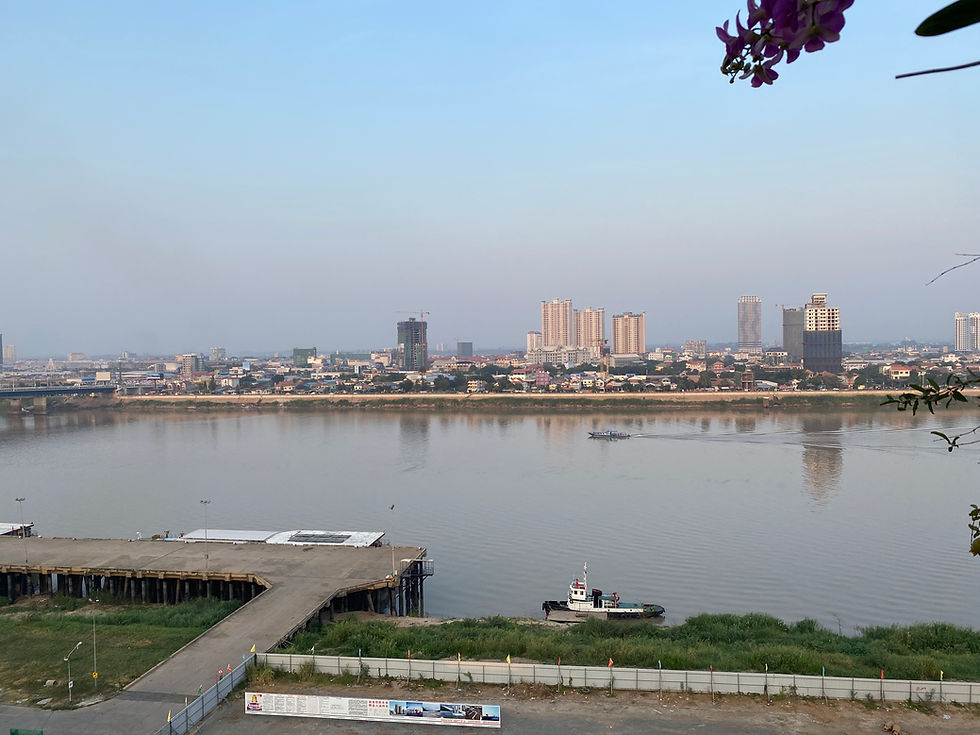Cruising Thru Cambodia
- Bil
- Jan 20, 2020
- 3 min read
Updated: Jul 4, 2021
As we cruise through the Cambodia countryside in the air-conditioned comfort of the Giant Ibis, I can’t help but wonder what the daily life is like for the people that we pass by.

What did they eat for breakfast? How did they get to work or school today? Is someone waiting for them to come home later?
There are the men working on the incomprehensible tangle of electrical utility wires, using bamboo ladders – do they worry about the risk inherent in that work and whether they will return home tonight? The woman with 3 young children on the motorbike – why aren’t they in school? Oh, wait, it’s Sunday. The men loading trucks in the covered sheds, the women standing in front of their food stalls waiting for customers, the usual procession of people walking along the road carrying mysterious bags that are probably rice and onions.
Where do they live? Go to school, go to eat, go to worship? Some clues are evident along the highway as we speed by, or slow down for busier areas. This stretch of the National

Highway between Siem Reap & Phnom Penh is marked by large, dry rice fields broken up by occasional villages and towns, which become larger and more frequent as we approach Phnom Penh.
This is the dry season, so the fields are brown and empty with smoky fires burning much of the time. Most of the rivers are very low, and the slow-moving water is a dark reddish brown. A few young men are wading in the shallows with cast nets or baskets to collect fish, snails and clams. Almost every single side road is made of dirt, with scooters and cars disappearing off into a cloud of dust.
The usual assortment of commerce describes the villages: cafes, motorbike accessories & repair shops, mini-groceries, mobile phone stores and laundry services. Some industrial

buildings with lumber or metal, furniture shops and tailors. There is a shop with 4 wooden caskets sitting outside – the first I have seen. One stretch of road looks to have a corner on the market for Buddhist temple supplies, with several yards full of gold & unpainted Buddhas of many shapes & sizes, alters, platforms and other iconic shapes of the faith. Maybe cast from concrete?
I am also intrigued by the varied forms of architecture in the houses and buildings that we

pass by. Most are raised up 2 or 3 meters on stilts, with the simplest being ancient one-room Khmer houses built with wooden poles and rafters, using thatching for roofing and sidewalls. But many are newer structures with concrete pillars and substantial construction. Some new construction I saw used concrete blocks for walls up to the roof. Roofs may be tile or metal sheathing in a plain gable or Khmer style. Some have 3 gable rooks in a row over the building. Most of the new construction buildings were usual metal framing and trusses.
There are many reasons for the elevated design, both spiritual and practical, and different folks will tell you different reasons why one is more important than the other. This silt-style house has been used for generations, so it is a traditional thing, but is also to emulate Mount Merat where the Hindu gods dwell. On a practical note, the home is elevated above animal threats like snakes and tigers and raised (hopefully) above flooding that may occur during the monsoon season. The shaded area below the house is used for storage or vehicles and tools, and many daily activities are carried out here rather than inside, until daytime temperature fall.

The simplest houses have a basic wooden ladder to reach the living quarters, whereas the more modern had split level staircases with an intermediate landing, some with fancy tile work. The front of many house had a large woven mat for an external window shade, and a few were quite intricate. There was a large variety of color schemes, from earth tones to bright tropical colors, and a few of the fancier ones had colorful ornamental iron railings and designs on the roof gables. The lovely aesthetics of the house fronts were frequently marred by the attachment of a business, such as a bike shop, garage or café. But that was probably how they financed the building of a nicer home.
Tall office towers in the near distance mean we are approaching the city and traffic is increasing as the air is growing hazy with smog. More of the bike riders are wearing face masks and helmets, so we say goodbye to the countryside for now as we cruise into the largest city in Cambodia – Phnom Penh.









Comments